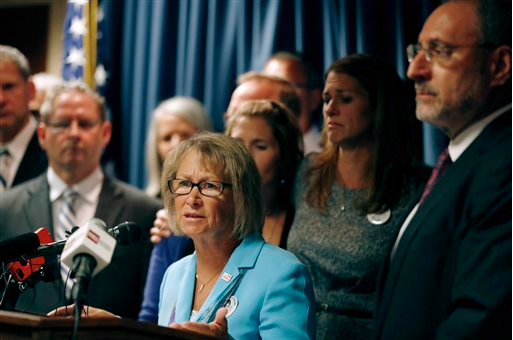
For nearly 27 years, one man knew where Jacob Wetterling was.
Late last month, Danny Heinrich agreed to confess to killing the 11-year-old boy — setting in motion a flurry of difficult negotiations between defense attorneys, investigators and prosecutors that would put him behind bars for decades and finally unlock the secrets to a mystery that has long haunted the state of Minnesota.
“This was not an opportunity we could pass up,” U.S. Attorney Andy Luger said. “After almost 27 years, Danny Heinrich was willing to talk, and we had to grab the moment.”
Heinrich, 53, admitted Tuesday that he abducted, sexually assaulted and shot Jacob to death in 1989, then buried the boy’s body in a field in rural central Minnesota. The confession came as part of a plea agreement in which Heinrich will likely get 20 years in prison on a federal child pornography charge when he’s sentenced in November, but will not be prosecuted on state murder charges. Following his prison sentence, a civil commitment is possible, meaning he could spend the rest of his life in custody.
As part of the deal, which the family approved, Heinrich led authorities to Jacob’s remains last week.
Some questioned whether the deal was enough punishment for the crime, which shattered childhood innocence for many rural Minnesotans, changing the way parents let their kids roam. Jacob’s smiling face was burned into Minnesota’s psyche, appearing on countless posters and billboards over the years.
Last year, authorities found images of child pornography at the Annandale home of Heinrich, who had long been under investigators’ scrutiny in Jacob’s disappearance. They recognized the best way to get to the truth was to pursue federal charges, which carry stiff penalties that could be used as leverage, Luger said.
Stearns County Attorney Janelle Kendall said too much time had passed to charge Heinrich with kidnapping or assault. A murder charge could still apply — but not without a body.
“To prove murder, we had to be able to prove that Jacob Wetterling died. Up until last Friday, proof that Jacob Wetterling was no longer alive did not exist.” Kendall said. “We did not have proof of murder, so we literally had to find Jacob in order to move forward at all.
“What was most important to the Wetterlings was to bring Jacob home and know what happened to him,” Kendall said. “Jacob would not have been found and the details wouldn’t have been told without the events of today.”
Luger added, “He’s not getting away with anything.”
In chilling detail, Heinrich stood before a federal judge Tuesday and calmly described how he abducted, molested and killed Jacob, as some members of the Wetterling family cried. Heinrich’s voice wavered at one point, but he showed little emotion in court —and Luger said he has expressed no remorse to authorities.
Heinrich said that on the night of Oct. 22, 1989, he saw Jacob, Jacob’s brother, and a friend bicycling down a rural road near Jacob’s home in St. Joseph. Heinrich laid in wait for the three to return, and when they did, he put on a mask and confronted them with a revolver.
Heinrich said he told the two other boys to run and not look back or he’d shoot. He said he then handcuffed Jacob and put him in his car, and Jacob asked: “What did I do wrong?”
Heinrich said he drove Jacob to a gravel pit near Paynesville and assaulted him. Afterward, Jacob asked whether he was taking him home.
“I said, ‘I can’t take you all the way home,'” Heinrich said. “He started to cry. I said, ‘Don’t cry.'”
Heinrich said at some point a patrol car with sirens and lights passing nearby caused him to panic. He said he pulled out his revolver, which had not been loaded, and put two rounds in the gun. He told Jacob to turn around, held the gun to the boy’s head and pulled the trigger, he said. The gun didn’t fire. Heinrich then fired two shots. After the second, Jacob fell to the ground.
Heinrich said he went home for a couple of hours, then went back to the gravel pit and buried Jacob about 100 yards away. He said he returned to the site about a year later and saw that Jacob’s jacket and some bones had become exposed, so he gathered what he could and re-buried the remains across the highway in a field.
The buried remains were identified as Jacob’s on Saturday.
“It’s incredibly painful to know his last days, last hours, last minutes,” his mother, Patty Wetterling, said after the guilty plea. “To us, Jacob was alive until we found him.”
Heinrich’s attorneys declined to comment after the hearing.
Authorities named Heinrich as a person of interest in Jacob’s disappearance last October when they announced the child pornography charges.
He had first been questioned shortly after Jacob’s abduction, but he maintained his innocence and authorities never had enough evidence to charge him. They turned a renewed spotlight on him as part of a fresh look into Jacob’s abduction around its 25th anniversary.
As part of that effort, investigators took another look at the sexual assault of 12-year-old Jared Scheierl, of Cold Spring, nine months before Jacob’s disappearance.
Using technology that wasn’t available in 1989, investigators found Heinrich’s DNA on Scheierl’s sweatshirt, and used that evidence to get a search warrant for Heinrich’s home, where they found the child pornography.
The statute of limitations had expired for charging him in the assault on Scheierl, but as part of Tuesday’s plea deal, Heinrich also admitted to that crime.
The AP typically doesn’t identify victims of sexual assault, but Scheierl has spoken publicly for years about his case, saying he hoped it could help investigators find his attacker and Jacob’s kidnapper.
In the years after Jacob’s disappearance, his mother became a nationally known advocate for missing children. A 1994 federal law named for Jacob requires states to establish sex offender registries.
